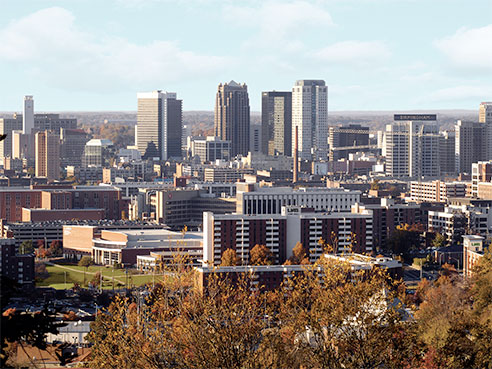Need more information? Contact us
 More than 200 people filled the UAB Alumni House on Oct. 1 to learn from experts from around the world on matters concerning urban sustainability and development at the 2015 Sustainable Smart Cities Symposium.
More than 200 people filled the UAB Alumni House on Oct. 1 to learn from experts from around the world on matters concerning urban sustainability and development at the 2015 Sustainable Smart Cities Symposium.
The symposium, organized by the UAB Sustainable Smart Cities Research Center, is an annual event that focuses on the innovations — such as big data, renewable energy and smart mobility — being used to help make Birmingham and other cities around the world smarter, safer and more livable.
In opening remarks, center director Fouad H. Fouad, Ph.D., who is also chair of the School of Engineering’s Department of Civil, Construction and Environmental Engineering, celebrated UAB’s collaborations with the city and called Birmingham’s new bike-share program “a big step forward for sustainability.”
Landscape architect Thomas Woltz, who was named Design Innovator of the Year for 2013 by the Wall Street Journal, was the event’s keynote speaker. Woltz designed a blocklong park and plaza to adjoin Alabama Power Company’s Powell Avenue Steam Plant redevelopment near Railroad Park in downtown Birmingham. He said Thursday that the new plaza should evoke the Magic City’s geology, rich history and industrial heritage.
“I hope this is a place where you can come with your children and tell stories about what you are as a city,” Woltz said.
In designing a large public space, Woltz says he and his staff — who are collaborating with several Birmingham design and construction firms — dig deep into the history and culture of an area. In this case, they wanted to reflect Birmingham’s mineral wealth and its status as an industrial and railroad hub.
“We want ideas that will be meaningful and relevant in a place,” Woltz said.
Other speakers included School of Engineering Dean Iwan Alexander, Ph.D., and Birmingham Mayor William Bell, who said that the city and UAB are “in the forefront of planning for the future.”
The city encourages developers to use LEED environmental standards in new construction, according to Bell. “In everything we do at city hall, we think about sustainability,” Bell said.
Additional speakers:
Rizwan Khaliq, director of Marketing and Communications for IBM Global Public Sector and Smarter Cities, discussed the link between technology and the economic competitiveness of cities around the world. He said that cities must work hard to build their brands and reputations as vital, livable places in order to attract the top, young talent they need to grow their economies.
This is more challenging now, since employees at companies like IBM can work remotely and live wherever they want, according to Khaliq. “Birmingham is not just competing with Louisville,” he said. “You are competing with cities in China. Each locality has to think about what it stands for from a branding perspective.”
Teresa Bouza, a journalist and the founder of Datafest, a hackathon that brings together technologists, data scientists and other experts to help solve problems in 48-hour weekend sessions, discussed the value of hackathons, which are being held all around the world. “When you bring people with diverse skills and backgrounds over just a weekend, it is incredible what they create,” she said.
She talked about the Smart Cities Hackathon held in Birmingham in 2015, in which UAB and Auburn University took part. In one project, a group radically improved the City of Birmingham website, where buyers can search for information about the roughly 5,000 blighted properties in the city’s recently created land bank.
Woltz, Khaliq and Bouza participated in a panel discussion about sustainability moderated by Molly Wasko, a professor at the UAB Collat School of Business. Also on the panel were Ann August, director of the Birmingham-Jefferson County Transportation Authority, and Christopher D. Hatcher, City of Birmingham urban design administrator.
The new park on Powell Avenue will attempt to harmonize with nearby Railroad Park, making visual use of a massive smokestack on top of the old steam power plant, and will use native plants and such indigenous materials as limestone to powerfully evoke the city’s industrial past, according to Woltz. “We are trying not to just make up stuff from the outside but do things that are actually a portrait of the city,” he said.
For more information about the Sustainable Smart Cities Research Center, call 205-996-2880 or visit www.uab.edu/smartcities.